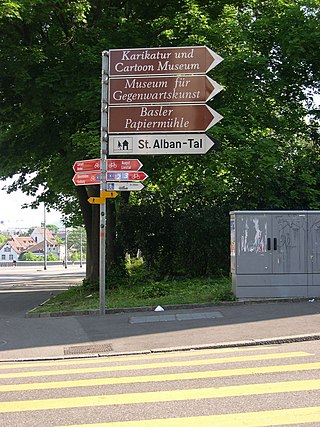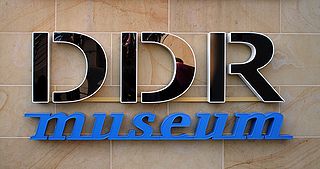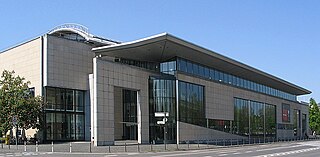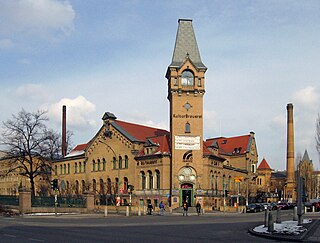
The Jewish Museum Berlin was opened in 2001 and is the largest Jewish museum in Europe. On 3,500 square metres of floor space, the museum presents the history of Jews in Germany from the Middle Ages to the present day, with new focuses and new scenography. It consists of three buildings, two of which are new additions specifically built for the museum by architect Daniel Libeskind. German-Jewish history is documented in the collections, the library and the archive, and is reflected in the museum's program of events.

The German Historical Museum, known by the acronym DHM, is a museum in Berlin, Germany devoted to German history. It describes itself as a place of "enlightenment and understanding of the shared history of Germans and Europeans". It is often viewed as one of the most important museums in Berlin and is one of the most frequented. The museum is located in the Zeughaus (armoury) on the Unter den Linden as well as in the adjacent Exhibition Hall designed by I. M. Pei.

The Topography of Terror is an outdoor and indoor history museum in Berlin, Germany. It is located on Niederkirchnerstrasse, formerly Prinz-Albrecht-Strasse, on the site of buildings, which during the Nazi regime from 1933 to 1945 was the SS Reich Security Main Office, the headquarters of the Sicherheitspolizei, SD, Einsatzgruppen and Gestapo.

Norbert Bisky is a German artist based in Berlin. He is one of the most important representatives of a new figurative painting in the 21st century.

The Documentation Center Nazi Party Rallying Grounds is a museum in Nuremberg. It is in the north wing of the unfinished remains of the Congress Hall of the former Nazi party rallies. Its permanent exhibition "Fascination and Terror" is concerned with the causes, connections, and consequences of Nazi Germany. Topics that have a direct reference to Nuremberg are especially taken into account. Attached to the museum is an education forum.

The Checkpoint Charlie Museum is a private museum in Berlin. It is named after the famous crossing point on the Berlin Wall, and was created to document the so-called "best border security system in the world". On display are the photos and related documents of successful escape attempts from East Germany, together with the escape apparatus: hot-air balloons, getaway cars, chairlifts, and a mini-U-boat. The museum researches and maintains a list of deaths at the Berlin Wall. It is operated by the Mauermuseum-Betriebs gGmbH, and the director is Alexandra Hildebrandt.

The Museum of Design, Zürich is a museum for industrial design, visual communication, architecture, and craft in Zurich, Switzerland.

The Schwules Museum in Berlin, Germany, is a museum and research centre with collections focusing on LGBTQ+ history and culture. It opened in 1985 and it was the first museum in the world dedicated to gay history.

The Basel museums encompass a series of museums in the city of Basel, Switzerland, and the neighboring region. They represent a broad spectrum of collections with a marked concentration in the fine arts and house numerous holdings of international significance. With at least three dozen institutions, not including the local history collections in the surrounding communities, the region offers an extraordinarily high density of museums compared to other metropolitan areas of similar size. They draw some one and a half million visitors annually.

The Tränenpalast is a former border crossing point between East and West Berlin, at Berlin Friedrichstraße station, which was in operation between 1962 and 1989. It is now a museum with exhibitions about Berlin during the Cold War period and about the process of German reunification. It was the border crossing for travellers on the S-bahn, U-bahn and trains going between East and West Germany. It was used only for westbound border crossings. It had separate checkpoints for West Berliners, West Germans, foreigners, diplomats, transit travellers and East Germans.

The DDR Museum is a museum in the centre of Berlin. The museum is located in the former governmental district of East Germany, right on the river Spree, opposite the Berlin Cathedral. The museum is the 11th most visited museum in Berlin.

Haus der Geschichte is a museum of contemporary history in Bonn, Germany. With around one million visitors every year, it is one of the most popular German museums. The Haus der Geschichte is, as well as the "Zeitgeschichtliches Forum Leipzig", the "Tränenpalast" am Bahnhof Friedrichstraße and the "Museum in the Kulturbrauerei" part of the Haus der Geschichte der Bundesrepublik Deutschland Foundation. The foundation's place of business is Bonn.

The Berlin Kulturbrauerei is a 25,000 square metres (270,000 sq ft) building complex in Berlin, Germany. Originally built and operated as a brewery, its courtyards and unique architecture have been protected as a monument since 1974 and it is one of the few well-preserved examples of industrial architecture in Berlin dating from the end of the 19th century.

The Märkisches Museum is a museum in Mitte, Berlin. Founded in 1874 as the museum of the city of Berlin and its political region, the March of Brandenburg, it occupies a building on the northern edge of Köllnischer Park, facing the Spree, which was designed by Ludwig Hoffmann and completed in 1908. It is now the main facility of the Stiftung Stadtmuseum Berlin, Landesmuseum für Kultur und Geschichte Berlins, the City of Berlin museum foundation, which also operates four other sites.

The Focke Museum is the museum of history and the history of art for the city and state of Bremen. It was formed in 1924 by the merger of a museum of industry and commerce and the previous historical museum, and is named for the founder of the latter, Johann Focke (1848–1922), a Bremen privy councillor and father of Henrich Focke. It is located in 4.5 hectares of grounds in the Riensberg neighbourhood of the city. In addition to a main building which opened in 1964 and was extended in 2002, the museum complex includes buildings dating from the 16th to the 19th centuries.
Margaretha Reichardt, also known as Grete Reichardt, was a textile artist, weaver, and graphic designer from Erfurt, Germany. She was one of the most important designers to emerge from the Bauhaus design school's weaving workshop in Dessau, Germany. She spent most of her adult life running her own independent weaving workshop in Erfurt, which was under Nazi rule and then later part of communist East Germany.

The Zeitgeschichtliches Forum Leipzig is a museum of contemporary German history. The museum was opened in 1999 and focuses on the history of the German division, everyday life in the communist dictatorship of the GDR, and the reunification process. It is located in the city center of Leipzig, Germany.

The Bayerisches Armeemuseum is the Military History Museum of Bavaria. It was founded in 1879 in Munich and is located in Ingolstadt since 1972. The main collection is housed in the New Castle, the permanent exhibition about the First World War in Reduit Tilly opened in 1994 and the Armeemuseum incorporated the Bayerisches Polizeimuseum in the Turm Triva in 2012. Today, part of the former Munich Museum building is the central building of the new Bayerische Staatskanzlei.

The Akademie der Künste der DDR was the central art academy of the German Democratic Republic (DDR). It existed under different names from 1950 to 1993. Then it merged with the "Akademie der Künste Berlin (West)" to become the Academy of Arts, Berlin.

The Kölnische Stadtmuseum is the municipal history museum of Cologne, North Rhine-Westphalia, Germany. It is housed in the building of the historic Zeughaus with the adjacent Prussian Alte Wache Zeughaus.



















